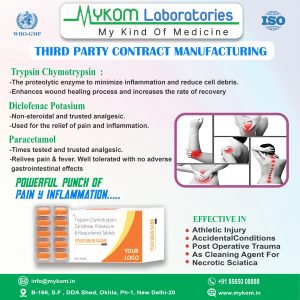
Third Party Pharma Manufacturing: E
In the ever-evolving pharmaceutical industry, the demand for cost-effective and efficient production methods has grown significantly. Third-party pharma manufacturing has emerged as a key solution to help pharmaceutical companies manage production costs, maintain high-quality standards, and enhance their market reach. This business model allows companies to outsource the manufacturing process to specialized contract manufacturers, enabling them to focus on core functions such as marketing, distribution, and innovation.
What is Third-Party Pharma Manufacturing?
Third-party pharma manufacturing, also known as contract manufacturing, involves outsourcing the production of pharmaceutical products to a third-party manufacturer. Companies enter into agreements with manufacturing partners who are equipped with state-of-the-art facilities and the expertise to handle the entire production process, from formulation to packaging. This approach eliminates the need for pharmaceutical companies to invest in costly manufacturing plants, regulatory certifications, and quality control processes, while ensuring that products are produced to the highest standards.
Key Benefits of Third-Party Pharma Manufacturing
- Cost Efficiency
The most significant advantage of third-party manufacturing is the reduction in operational and capital expenditures. Pharmaceutical companies can avoid the heavy costs associated with building and maintaining their own manufacturing facilities, investing in expensive equipment, and hiring specialized personnel. Instead, they can leverage the infrastructure and expertise of the contract manufacturer to produce their products at a fraction of the cost. - Focus on Core Competencies
Outsourcing production allows pharmaceutical companies to concentrate on what they do best—marketing, distribution, and research and development. By relying on a trusted third-party manufacturer, companies can streamline their operations and focus on innovation, building their brand, and expanding their market presence. - Regulatory Compliance and Quality Control
Reputable third-party manufacturers are well-versed in regulatory requirements and industry standards, including Good Manufacturing Practices (GMP) and ISO certifications. These manufacturers ensure that all products meet the necessary quality standards, reducing the risk of errors, recalls, and compliance issues. Partnering with a reliable contract manufacturer helps ensure that pharmaceutical companies maintain high-quality products without the burden of managing complex regulatory processes. - Scalability and Flexibility
Third-party manufacturers offer scalability, allowing businesses to quickly ramp up production when demand increases or scale back when necessary. This flexibility is particularly useful for companies looking to introduce new products to the market or cater to seasonal demand fluctuations. The ability to adjust production volumes without the need for large investments in infrastructure provides businesses with a competitive edge. - Faster Time to Market
Outsourcing manufacturing enables pharmaceutical companies to bring products to market faster. Third-party manufacturers have established processes and infrastructure that enable quick production turnaround times. With reduced lead times, companies can capitalize on market opportunities, respond to customer demand swiftly, and achieve faster revenue growth.
The Role of Third-Party Pharma Manufacturing in Business Growth
As the pharmaceutical industry becomes increasingly competitive, third-party pharma manufacturing offers a strategic solution for businesses aiming to expand their product lines and meet global demand. By partnering with a reliable contract manufacturer, pharmaceutical companies can introduce new formulations, reduce time-to-market, and enhance the availability of medicines in global markets.
Third-party manufacturing also allows companies to enter new markets more effectively by avoiding the challenges of establishing manufacturing operations in foreign countries. This model supports global expansion and helps businesses tap into emerging markets without the risk and complexity of building infrastructure in multiple regions.
Conclusion
Third-party pharma manufacturing is a vital strategy for pharmaceutical companies seeking to improve operational efficiency, reduce production costs, and maintain product quality. By leveraging the expertise and infrastructure of contract manufacturers, companies can focus on their strengths and grow their presence in the competitive pharmaceutical market. With its cost-effective and flexible solutions, third-party manufacturing continues to drive success for businesses, ultimately benefiting consumers by providing high-quality medicines at affordable prices.







